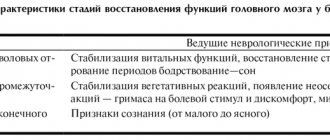What kind of disease is this
Cyclothymia is a mild form of manic-depressive psychosis. Its symptoms are less pronounced and it progresses more easily.
Elation constantly alternates with periods of depression. At the same time, the patient also experiences other cyclic changes associated with appetite, sociability, activity and a sense of self-confidence.
Mood swings occur regardless of any factors. Sometimes they are observed in stressful situations. The disease occurs more often in women in autumn and spring. If left untreated, this mental disorder can become chronic and lead to psychosis.
Patients with cyclothymia should not be entrusted with work related to repairing and driving a car, or raising children. Having this disease can be an obstacle to obtaining a driver's license. If you really want to drive, you need to remove or revise the diagnosis.
Study
Research debates whether subtypes of bipolar disorder, such as cyclothymia, truly represent distinct disorders or are part of a unique bipolar spectrum. Cyclothymia is not typically described in scientific studies or diagnosed in clinical settings, making it less recognized and less understood by professionals. The absence of cyclothymia in research and clinical settings suggests that cyclothymia is either being diagnosed as another mood disorder or a non-affective mental disorder, or is not receiving scientific or clinical attention due to a lack of diagnostic clarity or due to the nature of cyclothymia. is still highly contested. Additionally, the current diagnostic criterion for cyclothymia emphasizes that the symptoms are persistent, suggesting that they are enduring traits rather than a psychological condition, thus it has been argued that it should be diagnosed as a personality disorder. Because symptoms tend to overlap with personality disorders, the validity and distinction between the two diagnostic categories is debated.
Finally, the tendency for cyclothymia to co-occur with other mental disorders makes diagnosis difficult. These issues have hampered the achievement of consensus among researchers and clinicians regarding the definition of cyclothymia and its relationship with other mental disorders. This lack of consensus on the operational definition and presentation of symptoms is particularly pronounced in children and adolescents because diagnostic criteria have not been adequately tailored to their developmental level.
Symptoms
Signs of cyclothymia depend on the phase of the disease. There are only two of them:
- Manic. Manifested by euphoria, psychomotor agitation, hyperactivity. A person is ready to perform feats, he is very mobile.
His speech is fast and sometimes incoherent. He cannot concentrate, he grabs onto several things at once. The patient does not feel tired and does not understand that he has mental problems. If they try to calm him down, he expresses aggression. - Depressed. This phase comes suddenly, the patient suddenly becomes sad, withdrawn and taciturn, although only recently he strived to do great things. He has problems with sleep, apathy, fatigue, headaches, and negative thoughts.
An incomprehensible tension inside causes constant fears and anxiety. A person begins to think about his meaningless existence and even suicide. The depressive phase requires urgent help from a specialist, otherwise the consequences can be dire.
The patient often violates labor discipline, commits embezzlement, is able to enter into an illegal transaction and even commit a crime.
Persons suffering from cyclothymia who have committed offenses are considered sane if at that time they were not in a state of psychotic attack. In case of too frequent manifestations of the disorder, the patient may be declared insane (p. 21 of the Criminal Code of the Russian Federation).
Forms
Depressions that are observed with cyclothymia are divided into:
- Vital (endogenous or melancholic). A patient with this type of depression experiences deep melancholy and mental pain, a physical feeling of heaviness, a feeling of pressure, burning and squeezing in the heart, disturbances in appetite, libido, sleep, and sometimes there is a desire for death.
- Apathetic. They manifest themselves as a lack of motivation, decreased overall motivation and decreased vitality. Facial expressions become poor, movements are slightly slower, and speech becomes monotonous.
- Anesthetic. This type of depression is characterized by a painful feeling of alienation of emotions, there is an anxious, melancholy or apathetic affect, and a smoothness of its daily fluctuations. Erased psychomotor retardation or fussiness is observed. Depersonalization symptoms expressed to varying degrees may be observed (alienation of feelings and thoughts may be accompanied by a lack of hunger, the need for sleep, a feeling of dullness of the surrounding world, etc.).
Hypomanic phases can be mild (approaching hyperthymia), and their features depend on psychopathological factors and nuances of the personal, somatopsychic and vital spheres of a particular patient.
Causes
The main reason for the development of cyclothymia is a hereditary factor. Among the patient's relatives there are always people with depressive disorders.
The provoking factor for the development of the disease is improper upbringing of the child , namely:
- humiliation of him;
- lack of a general scheme for personality formation;
- constant criticism.
Cyclothymia is often observed in adolescents with sudden mood swings and strong feelings about unrequited love. The child may be in an angry state, commit rash acts, and communicate rudely. It happens that a son left home, disappeared for a long time and made his parents worry. This disorder is associated with hormonal imbalance and requires careful monitoring of the teenager. The indifferent attitude of others can lead to dire consequences.
Cyclothymia occurs in people who suffer from instability of the emotional sphere due to hyperactivity of hydrocortisone (a glucocorticoid hormone of a steroid nature), as well as in those who have drug or alcohol addiction.
Pathogenesis
Cyclothymia can occur:
- wave-like (the increase and decrease in the severity of phase oscillations is relatively uniform);
- in the form of episodes (can be double) with periods of restoration of the normal state.
On average, each patient has 4 phases (the second phase is observed in 50-60%, the third in 70%, and the probability of the fourth phase is 90%).
Bipolar cycles can be:
- 48-hour (maximum lability of alternating affect is observed);
- rapid (hypomania and depression replace each other every few days or weeks);
- seasonal (the formation of affective episodes occurs mainly in spring and autumn).
The disease can be observed throughout life after the onset, be temporarily interrupted or completely cease, or develop into bipolar affective disorder or recurrent depressive disorder.
If the debut of cyclothymia began with a hypomanic attack in adolescence, in 85–95% of cases the disorder will have a wave-like character.
Currently, most scientists adhere to the polygenic concept of disease development (this concept has replaced the hypothesis of monogenic dominant inheritance). According to this concept, the neurobiological abnormalities underlying the predisposition to cyclothymia are secondary links in pathogenesis. Such deviations are:
- Biological characteristics.
- Family burden (hereditary factor).
- Personal premorbid (the main character traits and its type that manifested themselves in the patient before the onset of the disorder). Develops in individuals with a cycloid temperament (characterized by internal balance combined with emotional responsiveness, kindness, natural behavior, affective instability).
The family burden in the proband (the person from whom the pedigree begins to be compiled during genealogical analysis) for unipolar phase disorders ranges from 11 to 18%, and for bipolar phase disorders - from 4 to 24% (these figures exceed population indicators).
Cyclothymia as a homotypic trait accumulates in families of probands.
The occurrence and development of cyclothymia is associated with impaired metabolism of monoamines, which are important neurotransmitters and neurohormones. The development of cyclothymia with a lack of neurohormones has been most studied:
- serotonin, which contributes to a person’s emotional stability and improves his mood;
- GABA (gamma-aminobutyric acid), which is an inhibitory neurotransmitter of the central nervous system;
- norepinephrine, which is one of the “wakefulness mediators”.
The development of the disease is also facilitated by reduced sensitivity of complementary target receptors to neurohormones.
According to numerous studies, cyclothymic depression in healthy people is caused by artificial diets in which there is a deficiency of L-Tryptophan (a precursor of serotonin). Such diets inevitably provoke an exacerbation of cyclothymic depression in patients.
In 70–80% of patients, phase affective disorders end in complete remission without the formation of negative disorders.
In some cases, incomplete thymopathic remissions are observed, in which mild affective symptoms may persist for a long time.
Test
There is a special test for cyclothymia online, which allows you to identify a person’s predisposition to a mental disorder. You can complete this study yourself by contacting a psychologist or finding one on the Internet.
The test helps determine the degree and phase of the disease and prescribe adequate treatment.
You must answer “yes” or “no” to questions related to specific behaviors. After self-checking, you can find an interpretation of the results and identify mental problems.
Diagnostics
First of all, you should make sure the diagnosis is correct. To do this, a psychiatrist or psychologist conducts a survey of the patient, as well as his relatives. The patient is asked to undergo a special test that will prove or disprove the presence of cyclothymia. It includes several questions and looks something like this:
- Do you alternate between moments of activity and lack of initiative?
- Does it ever happen that you want to implement big plans, but in the process your enthusiasm becomes less and less?
- Do you often change your mood for no reason?
- Is it easy for you to cope with hunger? Or do you become weak and irritated?
- Do external circumstances affect your mood?
- Does your emotional state depend on the time of year?
- Does it happen that during a conversation you lose interest in it?
- Have you ever gone to bed in a good mood, but woke up depressed and depressed?
- Do you have nightmares?
- Do you sometimes lose interest in everything that happens around you?
- Do you have periods of increased activity and then periods of inactivity?
- Does it happen that high spirits suddenly give way to apathy?
In this test the results are as follows:
- If the answers are “yes” from 10 to 12, this is cyclothymia.
- 5-9 positive answers indicate a tendency to this disorder.
- If you answered “yes” less than 4 times, you don’t have to worry. You are not at risk for cyclothymia.
Based on the results of the test and questioning of the patient, the doctor will determine in which phase the cyclothymia is. In case of a depressive period, treatment in a hospital will be required; in other cases, treatment at home is sufficient.
Treatment
Treatment of the disease is similar to the treatment of manic depression. For moderate symptoms of cyclothymia, it is performed on an outpatient basis.
In case of suicidal thoughts and severe manifestations of depression, hospital treatment is required. The main groups of drugs used to treat cyclothymia include:
- Neuroleptics . Necessary to eliminate hallucinations and suppress aggression. They are used only for pronounced symptoms of the disease due to the large number of side effects and contraindications.
- Normotimics . Used to stabilize mood. Lithium salts help get rid of sudden changes in behavior.
- Antidepressants . Helps cope with anxiety, depression, and bad mood.
In severe cases, the patient is given drugs intravenously. This allows his condition to stabilize much faster.
In modern medicine phototherapy , which is the effect of light on serotonin metabolism. After all, our mood depends on this “happiness hormone”. Light therapy can speed up the effects of antidepressants and is suitable for any type of such disorder.
Observation by a psychiatrist is mandatory. The specialist gives the patient confidence that everything will be fine, helps him feel protected, and teaches him how to deal with mood swings.
To prevent relapses of the disease, it is recommended to adhere to the following rules:
- To refuse from bad habits.
- Maintain a healthy lifestyle and get proper rest.
- Visit a psychotherapist regularly.
- You should completely take the course of medications prescribed by your doctor.
It is very important to provide the patient with the support of others. A healthy atmosphere, a positive attitude and the help of loved ones will help restore common sense to a person.
Why is cyclothymia dangerous?
Regular “swings” from periods of rise to periods of decline and back exhaust the nervous system. A person becomes easily excitable, nervous, and cannot predict how he will behave in a given situation.
Such unpredictability seriously affects personal and work relationships, prevents you from starting a family, interferes with your career, and pushes you to rash actions.
All this makes cyclothymia not a relatively harmless emotionality, but a full-fledged mental disorder, which is included F34.0 Cyclothymia in the International Classification of Diseases (ICD-10).
But the decline in quality of life is not the only problem. Over time, cyclothymia often develops into anxiety or bipolar disorder.
Forecast
According to experts, the prognosis depends on the internal balance and emotional responsiveness of the patient, the form of the disease, and the typicality of symptoms. The more balanced and responsive a person is, the better the outcome will be. Signs of a poor prognosis include depression with schizophrenia-like manifestations, especially at a young age.
In combination with medication, psychotherapy can achieve good results within a month after the start of treatment. It will take at least 6 months to strengthen the effect.
Video:
Online consultations with doctors
| Consultation with a child psychologist |
| Consultation with a massage therapist |
| Consultation with a plastic surgeon |
| Consultation with a cord blood bank specialist |
| Consultation with a cardiologist |
| Consultation with a diagnostician (laboratory, radiological, clinical diagnostics) |
| Consultation with a urologist |
| Consultation with a gynecologist |
| Consultation of general issues |
| Consultation with a trichologist (hair and scalp treatment) |
| Consultation with an andrologist-urologist |
| Consultation with a neurosurgeon |
| Consultation with an endocrinologist |
| Consultation with a treatment specialist abroad |
| Consultation with an anesthesiologist |
Medical news
Digital Pharma Day. Be at the forefront of the digital transformation of the pharmaceutical industry, 10/09/2020
The EpiLaser network has the lowest prices for ELOS hair removal in Kyiv, 09.14.2020
Generosity prolongs life, 09/07/2020
There is no universal diet, - scientists, 06/19/2020
Health news
The speed of spread of COVID-19 depends on climatic conditions, 06/11/2020
Researchers have counted six varieties of coronavirus, 06/11/2020
Scientists have found out how long it takes the sun to kill COVID-19, 05/28/2020
The head of WHO declared a pandemic COVID-19, 03/12/2020









